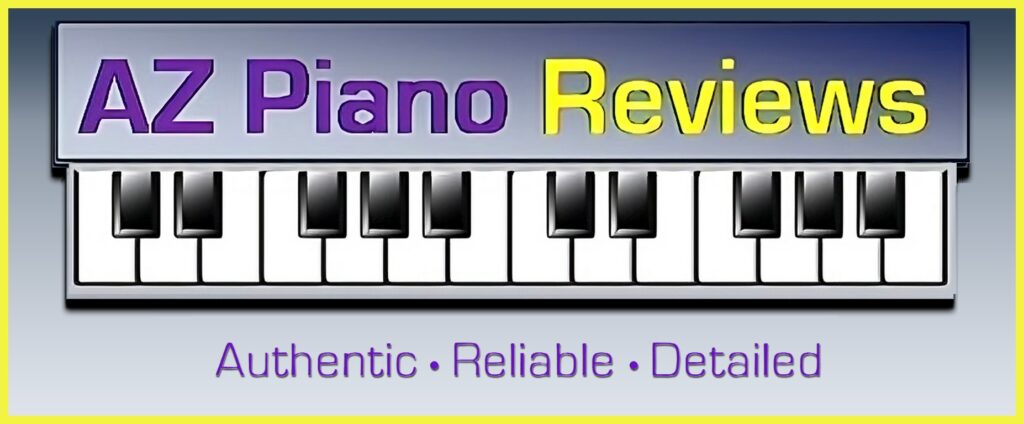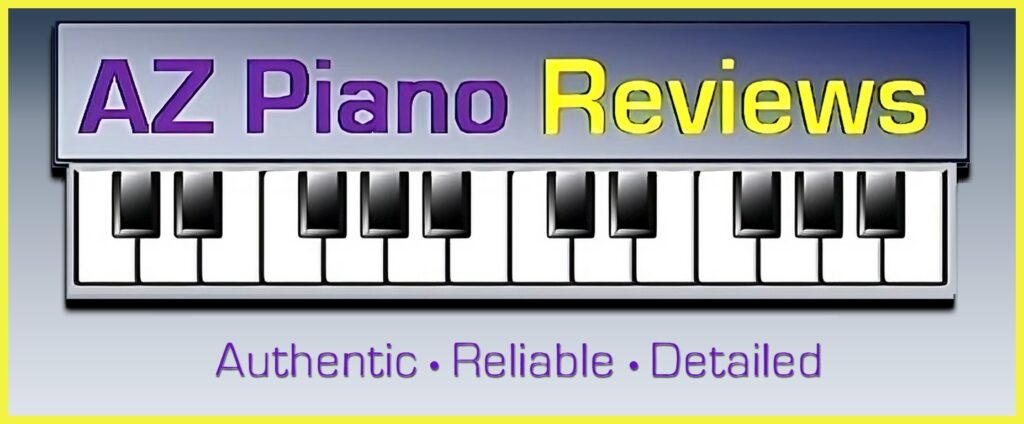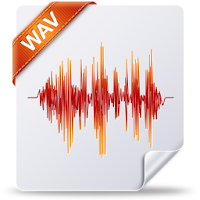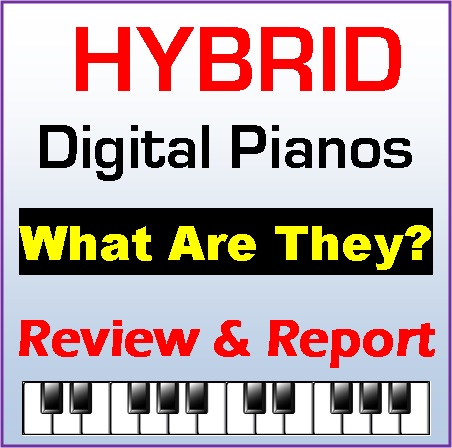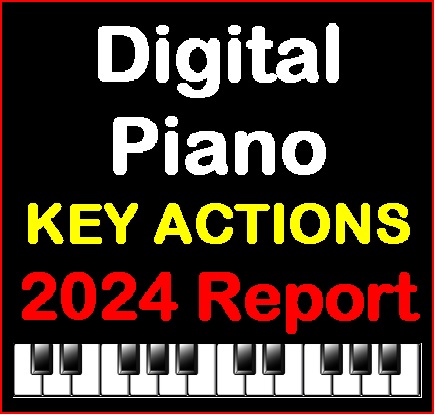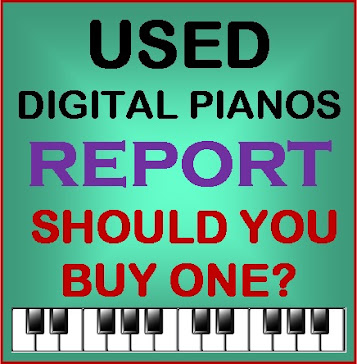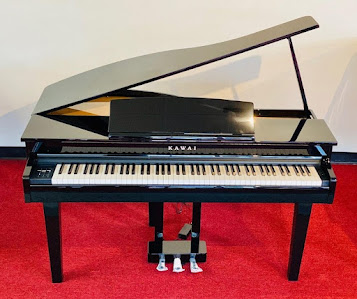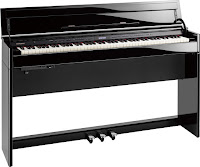 |
| DP603 polished ebony |
UPDATED REVIEW – December 1, 2019 – Roland DP603 Digital Piano – Recommended – The Roland corporation is known for producing some great musical instruments including digital pianos, synthesizers, guitar products, percussion, recording & audio equipment, and the list goes on. Many pro players as well as institutions own Roland digital pianos and Roland produces some good ones. Just like any manufacturer, not every product they make is a “home run” but the new Roland DP603 cabinet digital piano ($2499US internet price in satin black finish only – no bench) or the DP603 portable digital piano ($3099US internet price) in polished ebony or white finish including matching duet bench) are competitively priced and definitely offer a very satisfying piano playing experience with new technology and key action in a lower price range. Roland has had the DP line of pianos for many years but this is by far the best one yet. So for the Roland company I would call this one a “home run” for them.
| HP603 upgraded piano store model |
So what makes this new DP603 piano model so good? There are many things that I can point out that should give Roland a good reason to be proud of their accomplishment in creating this instrument and my review here is quite long and comprehensive which I believe is important so that people can make an informed decision. Before I go on further, I want to point out that Roland has had a new line of home style digital pianos out for awhile (nearly 1 year) with the exact same digital technology, functions, key action, and pedaling as is in the new DP603. In fact the DP603 is really just a less expensive version of the Roland HP603 home cabinet digital piano (which was just replaced by the new HP704) which is only found in local US Roland piano dealers and not for sale on-line in the US. The HP603 & HP704 sell for closer to $3000 in the Roland piano dealer stores but they come in a more formal, authentic piano cabinet with a very nice duet bench, have a different, much longer warranty, and the home pianos include an extensive accessory package at no charge. Otherwise the the new DP603 is virtually the same as the HP603 model, with the exception of cabinet design & structure and one Bluetooth feature.
 What is the difference between this new Roland model over the previous Roland models as well as compared to their their competition from Yamaha and Kawai? To start off, for the first time Roland has created a hybrid key action unlike anything they have done before. Each key consists of a combination of wood and plastic (instead of all plastic in the previous Roland models) and Roland claims this gives the key movement more authenticity and natural weight as well as eliminates maintenance of the all-wood key actions. Roland’s claim is that these new keys give the key structure more durability and more rigidity (with the addition of an inner stabilizer pin which also reduces lateral key movement) while allowing the action to feel more authentic with the wood in the keys to vibrate a bit from the sound waves when the “digital strings” are vibrating, as a key would normally do in a real acoustic piano. In other words, the
What is the difference between this new Roland model over the previous Roland models as well as compared to their their competition from Yamaha and Kawai? To start off, for the first time Roland has created a hybrid key action unlike anything they have done before. Each key consists of a combination of wood and plastic (instead of all plastic in the previous Roland models) and Roland claims this gives the key movement more authenticity and natural weight as well as eliminates maintenance of the all-wood key actions. Roland’s claim is that these new keys give the key structure more durability and more rigidity (with the addition of an inner stabilizer pin which also reduces lateral key movement) while allowing the action to feel more authentic with the wood in the keys to vibrate a bit from the sound waves when the “digital strings” are vibrating, as a key would normally do in a real acoustic piano. In other words, the 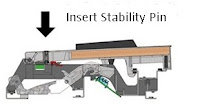 key is not all plastic and not all wood as you would normally find in the other popular digital piano brands and Roland would claim this is the best way to produce a key in a digital piano. I personally don’t know if it’s the best way to make a key and I doubt that the small amount of wood in the key does too much other than look nice, but as long as the keys move smoothly, are balanced well, and are graded weighted in a satisfying way, then that’s what I look for, and I believe this new key action called the PHA50 does all that. It is an upgrade to the previous key actions called the “Premium Action” which Roland had in their previous DP90e. Although I always felt that the Premium Key Action was very good and enjoyable to play, this new PHA50 action is even more so and I did notice some upgraded advantages.
key is not all plastic and not all wood as you would normally find in the other popular digital piano brands and Roland would claim this is the best way to produce a key in a digital piano. I personally don’t know if it’s the best way to make a key and I doubt that the small amount of wood in the key does too much other than look nice, but as long as the keys move smoothly, are balanced well, and are graded weighted in a satisfying way, then that’s what I look for, and I believe this new key action called the PHA50 does all that. It is an upgrade to the previous key actions called the “Premium Action” which Roland had in their previous DP90e. Although I always felt that the Premium Key Action was very good and enjoyable to play, this new PHA50 action is even more so and I did notice some upgraded advantages.
 It is definitely worth mentioning that the new top-of-the-line PHA-50 key action is on all of the new Roland models in the higher price ranges as well as this model here. This is not the case with Kawai and Yamaha digital pianos where they reserve their best upgraded key actions for their more expensive models. In fact, Yamaha’s best (CLP) digital piano key action is exclusively in their most expensive Clavinova piano called the CLP685 which retails for $6299US.
It is definitely worth mentioning that the new top-of-the-line PHA-50 key action is on all of the new Roland models in the higher price ranges as well as this model here. This is not the case with Kawai and Yamaha digital pianos where they reserve their best upgraded key actions for their more expensive models. In fact, Yamaha’s best (CLP) digital piano key action is exclusively in their most expensive Clavinova piano called the CLP685 which retails for $6299US.
So price alone in a digital piano does not necessarily determine quality or realism when compared to a real acoustic piano. Acoustic piano key actions vary from one piano to another, one brand to another, and there are differences between grand piano key actions and upright piano key actions. So when it comes to digital pianos key actions, the new PHA50 composite action (plastic + wood) in the DP603 is without question an upgrade to what was previously available in this price range before with regard to Roland digital pianos. This allows Roland to be more competitive with the other brands in this price range although the other major brands still have very good key actions, especially the Kawai ES8 which is less money than the DP603 but in our opinion plays better and sounds better than the Roland DP603..
 The newer Roland key action also has the “escapement feature” which more closely simulates the movement of grand piano keys when you press the keys down slowly and easily and you feel them slightly hesitate or have a notch or bump that occurs as you press the key down. This type of feeling is a natural occurrence on a real grand piano and helps with key control when playing music legato and slowly. You
The newer Roland key action also has the “escapement feature” which more closely simulates the movement of grand piano keys when you press the keys down slowly and easily and you feel them slightly hesitate or have a notch or bump that occurs as you press the key down. This type of feeling is a natural occurrence on a real grand piano and helps with key control when playing music legato and slowly. You can actually distinctly feel this “escapement” key action feature in the Roland pianos. However many of the newer Yamaha digital pianos in this price range, they do not have the escapement simulation feature. Kawai does have the escapement feature which they call “let-off” and that key action is also n the Kawai ES8 and many of their other digital pianos in this price range. Yamaha does offer the escapement key action feature but only in their full size cabinet pianos starting at around $2500US. But just because the feature (escapement) may be there doesn’t mean its simulates it well, and in my opinion the Roland escapement feature is more authentic but is still a simulation and not the real thing. Kawai also uses the escapement feature, which they call “let-off” (just another name for the same thing) and the Kawai feature is more pronounced and much more similar to Roland in that way.
Another thing I noticed about the new Roland key action was how much more quiet it was as compared with their previous models when the keys are moving up and down. By nature, regular acoustic piano key actions do make some noise when the keys are moving, but because those pianos are always so loud and they don’t have a volume control or headphone jack like digital pianos do, you cannot hear the key action noise when playing the piano. However in a digital piano, when you have the volume somewhere between low to medium level or when you are using headphones, then you can definitely hear the key action moving and noise is more of a concern. I can say for sure that the key action noise level on these new Roland pianos is the lowest that it’s been on any Roland digital piano and has surpassed the previous models for an even lower key movement noise reduction level. The previous models were already pretty good and more most people were satisfied with the fairly low ambient noise level of the moving keys. But the new PHA50 key action has definitely surpassed this and has become quieter and
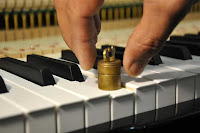 smoother in key movement and this is something that I think many people will appreciate, especially if you play at a higher skill level or you use headphones a lot. Gone are the days on older model Roland key actions when all you could really hear were the “thump” of the keys going down. When you combine this new Roland hybrid key with the quieter, smoother graded-weight (quick response) key movement along with good key action “down weight” & “up weight” return (measured by actual weights – left pic), you really feel like you can express yourself in a more authentic musically correct way as compared with previous models, at least that’s the way that I felt about it when playing this new key action. Then you add the nice escapement feature in the key action that I talked about along with Roland proprietary synthetic ivory & ebony feel keys (they do feel good), and the Roland company has really stepped up to the plate in a big way by improving upon what they already had in the previous models. This key action is not a major breakthrough in my opinion compared to previous models, but I believe that beginners through advanced players will appreciate it very much. The new PHA50 key action is available in all of the new Roland piano models rather than just in selected higher priced models such as what other brands offer.
smoother in key movement and this is something that I think many people will appreciate, especially if you play at a higher skill level or you use headphones a lot. Gone are the days on older model Roland key actions when all you could really hear were the “thump” of the keys going down. When you combine this new Roland hybrid key with the quieter, smoother graded-weight (quick response) key movement along with good key action “down weight” & “up weight” return (measured by actual weights – left pic), you really feel like you can express yourself in a more authentic musically correct way as compared with previous models, at least that’s the way that I felt about it when playing this new key action. Then you add the nice escapement feature in the key action that I talked about along with Roland proprietary synthetic ivory & ebony feel keys (they do feel good), and the Roland company has really stepped up to the plate in a big way by improving upon what they already had in the previous models. This key action is not a major breakthrough in my opinion compared to previous models, but I believe that beginners through advanced players will appreciate it very much. The new PHA50 key action is available in all of the new Roland piano models rather than just in selected higher priced models such as what other brands offer.
 When it comes to piano sound and getting as close to approximating or matching a real acoustic piano, there is no digital piano that can exactly reproduce a real acoustic grand piano sound regardless of what anyone else may say. It simply has never been done and no digital piano brand can rightly claim that they have done it. So the next best thing is “how close can a digital piano get to a real acoustic piano sound playing experience?” If you knew how complex a real acoustic piano sound actually is and what is actually happening in a good grand piano when it comes to the piano sound itself (what it does and how you hear it), you would probably drop your jaw open and think it would be impossible to recreate digitally because there are certain piano sound elements that happen in “real time” that are always changing depending on how fast or slow you play the keys, how hard or soft you hit (play) the
When it comes to piano sound and getting as close to approximating or matching a real acoustic piano, there is no digital piano that can exactly reproduce a real acoustic grand piano sound regardless of what anyone else may say. It simply has never been done and no digital piano brand can rightly claim that they have done it. So the next best thing is “how close can a digital piano get to a real acoustic piano sound playing experience?” If you knew how complex a real acoustic piano sound actually is and what is actually happening in a good grand piano when it comes to the piano sound itself (what it does and how you hear it), you would probably drop your jaw open and think it would be impossible to recreate digitally because there are certain piano sound elements that happen in “real time” that are always changing depending on how fast or slow you play the keys, how hard or soft you hit (play) the 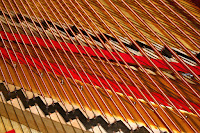 keys, the type of wood the piano is made of, how much soundboard space you have in the real piano, the types of hammers and key felt that is part of the key action, the vibrations and overtones of the 230 strings (give or take) in a real grand piano and how they all interact with each other including the random vibrations, sympathetic noises, frequency changes, tonal dynamics, string thickness, string windings and materials, the scale design, the piano iron frame, dampers and their affect on the sound, decay and sustain time of the sustained strings, volume, duration of the tone and changes in velocity, among other things. Even the the style of music you play such as chording, voicing of chords, staccato and legato of the notes, and the interaction of the string vibrations on the body of the piano all contribute to the final outcome of the sound. Not only are the key action elements quite complex in a real acoustic piano, but in a lot of ways the piano sound is even more complex and trying to get that “perfect” reproduction which people are looking for in a digital piano is very difficult given the current technology that most digital piano companies are using.
keys, the type of wood the piano is made of, how much soundboard space you have in the real piano, the types of hammers and key felt that is part of the key action, the vibrations and overtones of the 230 strings (give or take) in a real grand piano and how they all interact with each other including the random vibrations, sympathetic noises, frequency changes, tonal dynamics, string thickness, string windings and materials, the scale design, the piano iron frame, dampers and their affect on the sound, decay and sustain time of the sustained strings, volume, duration of the tone and changes in velocity, among other things. Even the the style of music you play such as chording, voicing of chords, staccato and legato of the notes, and the interaction of the string vibrations on the body of the piano all contribute to the final outcome of the sound. Not only are the key action elements quite complex in a real acoustic piano, but in a lot of ways the piano sound is even more complex and trying to get that “perfect” reproduction which people are looking for in a digital piano is very difficult given the current technology that most digital piano companies are using.
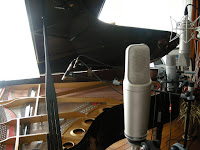 I am a long time piano teacher and pro musician of 40 plus years having taught thousands of students as well as owning, playing on, and teaching acoustic guitar. When it comes to natural grand piano sound, to me that is what it’s all about…beauty, soul, feeling, the piano sound being alive and not digital sounding, and feeling like when you play a song, you can play it may times and every time it comes out a bit differently because a real piano sound is “alive & breathing” and changes, and is not canned, digital, dead, plunky, or without taste or expression. I mention all of this so that you will better understand what I am about to share with you. Up until now, Roland, Yamaha, Kawai, and Casio, the four main digital piano companies out there, have been using “sample recording” technology to capture piano sound from a real piano and then put it into the digital micro-processor chip in the digital piano so that it comes out of the speakers and sounds as much like a real piano as possible using that sampling technology. The “samples” or recordings are of each piano note (not each string) on a particular brand and model of acoustic grand piano at different velocity levels when pressing the keys and those recordings, which are done by microphones inside and over the acoustic piano, are shorter samples of the sound due to digital memory constraints. This is true for all major brand digital pianos. Yamaha uses Yamaha acoustic grands, Kawai uses Kawai acoustic grands, and so on. The sample is then electronically “looped” into a continuous virtual circle/loop so that it will sound like it is continuous
I am a long time piano teacher and pro musician of 40 plus years having taught thousands of students as well as owning, playing on, and teaching acoustic guitar. When it comes to natural grand piano sound, to me that is what it’s all about…beauty, soul, feeling, the piano sound being alive and not digital sounding, and feeling like when you play a song, you can play it may times and every time it comes out a bit differently because a real piano sound is “alive & breathing” and changes, and is not canned, digital, dead, plunky, or without taste or expression. I mention all of this so that you will better understand what I am about to share with you. Up until now, Roland, Yamaha, Kawai, and Casio, the four main digital piano companies out there, have been using “sample recording” technology to capture piano sound from a real piano and then put it into the digital micro-processor chip in the digital piano so that it comes out of the speakers and sounds as much like a real piano as possible using that sampling technology. The “samples” or recordings are of each piano note (not each string) on a particular brand and model of acoustic grand piano at different velocity levels when pressing the keys and those recordings, which are done by microphones inside and over the acoustic piano, are shorter samples of the sound due to digital memory constraints. This is true for all major brand digital pianos. Yamaha uses Yamaha acoustic grands, Kawai uses Kawai acoustic grands, and so on. The sample is then electronically “looped” into a continuous virtual circle/loop so that it will sound like it is continuous 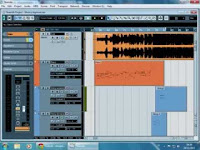 in real time linear playback. But when you play a real piano, the piano sound starts when you first touch the key and hear the sound and then it stops when you let go of the key and pedal. That acoustic piano sound is one straight continuous sound in real time. Sampled recording is actually taking a slice or piece of that original piano sound and then is looped in a virtual circle, as I just mentioned, so it plays over & over and is not actually changing in real time. Picture a hula-hoop going around & around. The hula-hoop is a circle fastened together at a starting & ending point much like a sample recording is done. This is the way piano sound is heard on a digital piano. Depending on how and where the loop is electronically fastened together, you may or may not hear a noticeable or slight anomaly (depending on how the loop was put together) or a slight anomaly tone when the loop starts over. In other words, the sound will end and then quickly start over while you are holding the piano key down. It just depends on your ears and how sensitive they are to a real piano sound and how good the sampling process was on the brand & model. Kawai, Yamaha, and the new Casio Hybrids all do a very good job with their sample looping and hearing the loop point is virtually impossible on some of those models, but the off-brands are where you notice problems in the sampling process.
in real time linear playback. But when you play a real piano, the piano sound starts when you first touch the key and hear the sound and then it stops when you let go of the key and pedal. That acoustic piano sound is one straight continuous sound in real time. Sampled recording is actually taking a slice or piece of that original piano sound and then is looped in a virtual circle, as I just mentioned, so it plays over & over and is not actually changing in real time. Picture a hula-hoop going around & around. The hula-hoop is a circle fastened together at a starting & ending point much like a sample recording is done. This is the way piano sound is heard on a digital piano. Depending on how and where the loop is electronically fastened together, you may or may not hear a noticeable or slight anomaly (depending on how the loop was put together) or a slight anomaly tone when the loop starts over. In other words, the sound will end and then quickly start over while you are holding the piano key down. It just depends on your ears and how sensitive they are to a real piano sound and how good the sampling process was on the brand & model. Kawai, Yamaha, and the new Casio Hybrids all do a very good job with their sample looping and hearing the loop point is virtually impossible on some of those models, but the off-brands are where you notice problems in the sampling process.
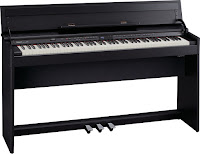 |
| previous model DP90e |
For a large majority of people playing piano these days and regardless of skill level, the piano sampling technology has produced some very enjoyable piano sound in digital pianos and this technology has gotten better and more sophisticated with time, and the end result is some mighty impressive digital piano instruments that have recently come out from the other brands. Along with increasing sampling sophistication also has come increased polyphony in sampled digital pianos up to 256-notes. This means that when playing a digital piano, if you are at a higher skill level and play complex musical passages using a stereo piano sound, you won’t run out of notes as you play your music using many keys and pedal sustain at one time along with doing glissando’s, arpeggios, and or lots of chording. So when it comes to piano sound, the digital piano industry has come a long way in being able to reproduce it with sampled recording so that most people can be very happy with the results, depending on your budget and the brand of piano of course:)
 However, Roland has now gone beyond the standard industry piano sound sampling technology by introducing a new sound technology for the DP603 called SuperNATURAL piano Modeling. Modeling (aka: modelling) is different from sampling in the way the sound is created and the way you hear it when the piano is being played. Along with this technology being implemented to create an all new piano sound not found in any other major brand, Roland is putting it in all of their new models instead of just a few at the top of the price range. This means that you can get this new technology of piano sound reproduction starting at around $3000 in their cabinet models. It is typical for digital piano companies to reserve their best features for the most expensive models to get you to spend more
However, Roland has now gone beyond the standard industry piano sound sampling technology by introducing a new sound technology for the DP603 called SuperNATURAL piano Modeling. Modeling (aka: modelling) is different from sampling in the way the sound is created and the way you hear it when the piano is being played. Along with this technology being implemented to create an all new piano sound not found in any other major brand, Roland is putting it in all of their new models instead of just a few at the top of the price range. This means that you can get this new technology of piano sound reproduction starting at around $3000 in their cabinet models. It is typical for digital piano companies to reserve their best features for the most expensive models to get you to spend more
money but Roland did not do this, and that is impressive to me and I commend them for that. So exactly what is SuperNATURAL Modeling technology and what makes it different then all other digital pianos? In Sampling technology, the sound elements in a real piano need to be recorded with microphones, as I previously mentioned, and then those recordings need to be translated into computers and then saved in the digital piano sound chips on circuit boards. The recordings can be of a number of different things in a piano including the sound reproduction as you strike a key at different velocities and the noise the hammer makes when it moves, just to name a few. Sampled sounds take a larger amount of computer memory to do it correctly (or as close as can be done), and that may or may not drive up the cost of those instruments. But those sound element recordings never change and cannot “think” on their own such as what real acoustic pianos do in the natural physical world. The technology is also limited by the recording microphones and their ability to get a pure organic sound through the air.
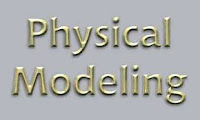
Physical Modeling sound is not recorded from an acoustic piano but is created through non sampling computer mathematical algorithms. I am definitely not a mathematician so the best explanation I found on the subject which I believe is important to understand (at some level) so that you can appreciate this new piano sound technology, is as follows: “In sound synthesis, physical modeling synthesis refers to methods in which the waveform of the sound to be generated is computed by using a mathematical model or formula, being a set of equations and algorithms to simulate a physical source of sound, usually a musical instrument. Such a model consists of laws of physics that govern the sound production, and will typically have several parameters, some of which are constants that describe the physical materials and dimensions of the instrument, while others are time-dependent functions that describe the player’s interaction with it, such as plucking a string, or covering toneholes. For example, to model the sound of a drum, there would be a formula for how striking the drumhead injects energy into a two dimensional membrane. Thereafter the properties of the membrane (mass density, stiffness, etc.), its coupling with the resonance of the cylindrical body of the drum, and the conditions at its boundaries (a rigid termination to the drum’s body) would describe its movement over time and thus its generation of sound.” That’s the explanation I found that best explains this technology although if you don’t understand it…don’t worry, a lot of other people don’t either:).
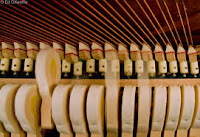 In piano sound physical modeling, that technology is dealing with things such as the energy/force you put into the playing the keys, the interaction of the tonal dynamics, piano hammers, felt movement on the hammers, string movement over time, overtones that excite other moving and non-moving parts of the strings and wood cabinet, and many more physical aspects of a real acoustic piano.,..and all of these physical properties in a real piano are recreated by computer computations. It’s like a powerful computer that draws a “virtual picture” of every aspect of the best
In piano sound physical modeling, that technology is dealing with things such as the energy/force you put into the playing the keys, the interaction of the tonal dynamics, piano hammers, felt movement on the hammers, string movement over time, overtones that excite other moving and non-moving parts of the strings and wood cabinet, and many more physical aspects of a real acoustic piano.,..and all of these physical properties in a real piano are recreated by computer computations. It’s like a powerful computer that draws a “virtual picture” of every aspect of the best
acoustic grand piano possible and then that “virtual picture” instantly comes to life as that actual acoustic piano played instantly in micro seconds with no repetition or sameness. This gives you the feeling that the piano sound which you’re hearing is being generated from an real acoustic piano, when in fact is is all done in the virtual technology world.


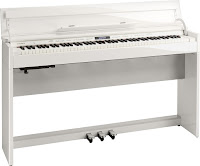
Roland has tried to emulate the Steinway Concert grand piano sound over the years and that’s what they have tried to do here in getting them (or trying to get them) to behave much the same way as the real thing does. Having this kind of technology gives the player an approximation of Steinway grand sound characteristics without the large size and expense of that acoustic piano. In fact, it could be said that the new Roland digital piano sound is so lifelike and organic that it sounds a bit like there are no speakers in the digital piano itself and that the sound is naturally occurring within the cabinet and not coming through speakers…but obviously there are speakers and to a trained ear like mine, there is still a noticeable difference between the “real thing” acoustic piano and these Roland digital pianos…but I expected that…and in fact the speaker technology still has a long way to go. An example of the new Roland sound is when you press any one key on the Roland piano without having any additional reverb or sound effects on, that one note will also trigger natural occurring “overtones” for that specific note that you would normally and naturally hear in a real piano. Just take my word for it, it really does do that and no other major digital piano brand has that capability at the moment. Also, just when a person thought that 256-note polyphony processing power for the piano sound was a lot, the new Roland physical modelling technology has jumped that polyphony number up to…infinity and beyond:)…in other words…unlimited polyphony. There is no limit because of the way the sound is generated in the virtual physical world. However, the 256-note polyphony in other name brand pianos is way more than enough to power even some of the most complex piano music that a person can play. The unlimited polyphony on the Roland pianos is for the acoustic piano sounds only but not for the non-acoustic piano instruments such as electric pianos, strings, organs, choirs, brass, etc. Those sounds offer 384-note polyphony which is also more than the other brands do, but once again, not something that you’ll actually notice when playing these instrumental sounds. Also, polyphony power has nothing to do with the actual instrument sound samples and the authenticity of those tones and some of the extra instrument tones in the DP603 are very good and others not so much. However, when you combine that polyphony power along with a 3-sensor key action, the musical expression and dynamic tonal & volume range you get in this new piano is very impressive. From very soft pianissimo to extra loud forte volume. the DP603 goes beyond what a person might otherwise expect out of a digital piano, particularly a Roland digital piano.
 |
| Physical Modeling Virtual Technology |
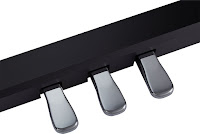 I did want to mention something about pedaling and the fact that without proper pedaling response and reproduction, the pedal movement, sound, & sustain that occurs from pedaling, especially with the right damper pedal, would not be nearly as enjoyable and could even create some poor pedaling habits. The right damper pedal is critical for allowing the music that you play on a piano sound good. The right pedal produces the sustain which holds the notes for a duration of time after you play the key(s) while the right pedal is held down. Physically it’s a fairly simple process
I did want to mention something about pedaling and the fact that without proper pedaling response and reproduction, the pedal movement, sound, & sustain that occurs from pedaling, especially with the right damper pedal, would not be nearly as enjoyable and could even create some poor pedaling habits. The right damper pedal is critical for allowing the music that you play on a piano sound good. The right pedal produces the sustain which holds the notes for a duration of time after you play the key(s) while the right pedal is held down. Physically it’s a fairly simple process
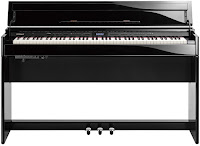 overall pushing down the pedal and playing the notes, but in reality the process is much more complex as far as what you will actually hear and experience when doing that. In the world of digital pianos one of the most noticeable things that occurs with the right damper/sustain when holding it down (while playing notes) is the lack of sustain/decay time, especially on the middle octaves up through the last octave. In other words, the decay time of the notes die off more quickly than they should when the sustain pedal is held down. Therefore the song is more choppy and the transitions between notes and chords are not nearly as realistic as they should be. In a real acoustic piano when you press the right damper pedal down, you will not only get long sustain time but also the sustained volume will stay louder and stronger over time as well as the interaction of the sustained strings sound more complex with noticeable overtones, harmonics, and a variety of vibrations all happening in real time. The new Roland DP603 does an excellent job of trying to recreate a real pedaling and piano note sustain experience using this new physical modeling technology. However, occasionally when playing certain chords or notes together in various octaves, especially in the middle octaves, I did notice too much mid range sustained tones (especially when I was using the damper pedal) that were unlike a real piano. This gave me the impression that the sustained piano tone (while using the damper pedal) was somewhat overdone and not natural like a real piano is. I tried to compensate for this by editing the piano sound in different ways with sound editing functions as well as reducing sustain/decay time with less pedaling, and that did help a little, but did not eliminate it altogether and it was still noticeable to me. As with all new technologies, physical modelling is not perfect yet and Roland will no doubt get it to become better over the years to come, but for now it’s still very impressive. Roland also uses continuous pedal recognition which follows your incremental pedal movements instead of having just the standard half-pedal recognition found in other brands. Nevertheless, it was very nice for me to experience all these features in these new Roland pianos and until you get to a more advanced piano playing skill level where you can really appreciate these features, it may not matter to you…but I guarantee it does make the music become more alive and sound more authentic. The middle and left pedals do function well and will stand up to more advanced players. But because those pedals are not played near as much as the right pedal, then the right pedal is the one most people will be familiar with and if that’s what you want then overall you should be very happy with the pedaling functions and features.
overall pushing down the pedal and playing the notes, but in reality the process is much more complex as far as what you will actually hear and experience when doing that. In the world of digital pianos one of the most noticeable things that occurs with the right damper/sustain when holding it down (while playing notes) is the lack of sustain/decay time, especially on the middle octaves up through the last octave. In other words, the decay time of the notes die off more quickly than they should when the sustain pedal is held down. Therefore the song is more choppy and the transitions between notes and chords are not nearly as realistic as they should be. In a real acoustic piano when you press the right damper pedal down, you will not only get long sustain time but also the sustained volume will stay louder and stronger over time as well as the interaction of the sustained strings sound more complex with noticeable overtones, harmonics, and a variety of vibrations all happening in real time. The new Roland DP603 does an excellent job of trying to recreate a real pedaling and piano note sustain experience using this new physical modeling technology. However, occasionally when playing certain chords or notes together in various octaves, especially in the middle octaves, I did notice too much mid range sustained tones (especially when I was using the damper pedal) that were unlike a real piano. This gave me the impression that the sustained piano tone (while using the damper pedal) was somewhat overdone and not natural like a real piano is. I tried to compensate for this by editing the piano sound in different ways with sound editing functions as well as reducing sustain/decay time with less pedaling, and that did help a little, but did not eliminate it altogether and it was still noticeable to me. As with all new technologies, physical modelling is not perfect yet and Roland will no doubt get it to become better over the years to come, but for now it’s still very impressive. Roland also uses continuous pedal recognition which follows your incremental pedal movements instead of having just the standard half-pedal recognition found in other brands. Nevertheless, it was very nice for me to experience all these features in these new Roland pianos and until you get to a more advanced piano playing skill level where you can really appreciate these features, it may not matter to you…but I guarantee it does make the music become more alive and sound more authentic. The middle and left pedals do function well and will stand up to more advanced players. But because those pedals are not played near as much as the right pedal, then the right pedal is the one most people will be familiar with and if that’s what you want then overall you should be very happy with the pedaling functions and features.
With regard to all of the fundamental parts of piano playing which I have just talked about including key action, piano sound, and pedaling. if all there was on this model was that you just turned on the power and started playing piano, that may be enough for some people. But for other people who enjoy “tweaking” and customizing the sound, feel, and overall piano playing response, Roland has included a huge amount of editing functions called “Piano Designer” just for that very purpose. In fact many of these functions are quite useful and allow people the opportunity of personalizing the playability along with the piano sound to their particular tastes and playing experience in a number of ways. These features are fairly easy to use although they may be “over-the-top” for some people, but that’s OK because it’s better to have them then to not have them in my opinion. In regular acoustic pianos there are ways that a piano technician-tuner can personalize and customize the piano sound and key action but that can be an expensive process. In the Roland digital pianos this process is in the “digital domain” so it’s free, right at your fingertips by the press of a couple of buttons and you use your ears, fingers, and foot to determine what you like and don’t like. Once you make a change to the overall piano sound you can then save it to a power-up memory. However the piano also has an instant memory feature which saves your changes as you go
without needing to do anything extra…a very cool feature that I have not seen before in pianos like these. If you don’t want those saved changes anymore you can then just reset the piano easily to the factory default settings. Some of the sound editing changes that you can do include Grand Piano Lid height position, Key Off Noise, Hammer Noise, Duplex Scale adjustment, Full Scale String Resonance, Damper Resonance, Key Off Resonance, Cabinet Resonance, Soundboard Type, Damper Noise, Single Note Tuning, Single Note Volume, Single Note Character, 100 levels of key touch velocity (the way the keys respond to your touch) along with multiple levels of Ambience/Reverb and Brilliance customization. All of the functions and buttons are accessed along the top the keys on the control panel. In my opinion this is the most intuitive and usable placement of controls, display screen, and button placement on a digital piano although Kawai has the same control panel placement and that’s a good thing. So when it comes to just playing the piano, you can do it the old traditional way and simply power up the Roland piano and play, or you can edit and personalize the sound in just about any way you want to and see what you’re doing in the nice LCD display screen in the center of the piano above the keyboard.
Ok…so now it’s on to some of the useful digital features and non-piano sounds and functions these new pianos have. The new Roland pianos have 4 Physical Modeled grand piano sounds including Concert, Ballad, Mellow, and Bright with the ability to edit them in 100’s of ways as I mentioned earlier. It is not the
quantity of individual piano sounds that count but it is the quality. Beyond those physical modeled sounds are the addition of 8 more piano types including upright, ragtime, and Forte pianos. There are a total of 307 instrument sounds on the new Roland cabinet pianos including some outstanding symphony string orchestras, vintage
harpsichords, vintage electric pianos, pipe and pop organs, church and pop choirs, concert harp, classical guitar, oboe, concert flute, jazz saxophone, bluegrass banjo, synthesizer, movie sound effects, and just about anything else you can think of. However, the new Roland pianos have an annoying issue with regard to changing instrument sounds when you are playing live in real time (including the piano sounds) that they did not have on previous models, and this is called “all notes off” function. This means when you change from one sound to the next such as piano to harpsichord, concert piano to mellow piano, electric piano to strings, guitar to flute, etc, if you are holding down or playing one or more keys (and/or holding down your sustain pedal) to continue to hear the current sound you have and then changing sounds in the control panel to go to the next sound you want, the current sound immediately cuts off and stops playing until you re-key and start playing again. This is especially annoying when playing in a live setting, event, etc, and wanting to change sounds in the middle of a song. The sound to sound transition is not smooth, but instead it’s choppy and just irritating. It’s interesting to note that on previous Roland models they did not have this problem and changing sounds was smooth, flowing, and worked fine as it does on the other major brands and models. However perhaps this issue is due to the new Physical Modeling technology and Roland has not figured out a way to overcome this noticeable anomaly. I personally play in a lot of “live situations” and count on being able to change sounds quickly and smoothly during a performance with any “hiccups.” But on these new Roland pianos this is not possible unless Roland can come up with an update to solve this problem.
 A lot of people say to me “I don’t want or need a lot of extra instrument sounds, so if the piano just has some great piano tones, key action, and pedaling, then that’s my main focus.” As a piano teacher and pro musician I totally understand and agree with that, to a point, but there are some good reasons to have all of those extra instrument sounds on the piano such as being able to make a multitrack, multi-instrument recording or using what is called “General MIDI” song playback. All Roland piano models can play back General MIDI song files from a USB flashdrive which is a great feature and one I use quite often in my studio for song learning and teaching.
A lot of people say to me “I don’t want or need a lot of extra instrument sounds, so if the piano just has some great piano tones, key action, and pedaling, then that’s my main focus.” As a piano teacher and pro musician I totally understand and agree with that, to a point, but there are some good reasons to have all of those extra instrument sounds on the piano such as being able to make a multitrack, multi-instrument recording or using what is called “General MIDI” song playback. All Roland piano models can play back General MIDI song files from a USB flashdrive which is a great feature and one I use quite often in my studio for song learning and teaching.
The General MIDI/GS song format allows you to play your piano parts live along “with the band or orchestra” in prerecorded MIDI songs and to interact with multiple instruments (up to 16 tracks) at one time using well known piano lesson books including thousands of popular songs off the internet from a variety of music styles and eras such as Jazz, Latin, Country, Rock, Gospel, Christian, movie themes, classical orchestra, pop, and much more which can be found on the Internet. Some of this music is free and some costs money. For more info on the General MIDI format go here: General MIDI and Playing Piano. The MIDI song titles (and page numbers depending on the files) can be accessed and seen from the LCD user display screen on the piano which makes using it easier to know what song your flashdrive is playing as compared to only having LED display screens or none at all. With Yamaha Clavinova CLP digital pianos for example, the only model that has the General MIDI song format is the top of the line CLP585 which is priced at $5000 and up. With Kawai digital pianos the only cabinet model with General MIDI playback format is priced at about $2500US which is good. However, all of the new Roland cabinet pianos have this helpful and entertaining songplay and lesson learning format starting with this DP603, so their models cover all the price ranges and cabinet styles. I will say that using the MIDI song playback feature is definitely not intuitive in this piano or any of the other Roland models above this one. There is no clear instruction in the owners manual on how to do it correctly and trying to figure it out on your own can be frustrating. It even took me awhile to get the hang of it (and I have lots of experience with these things) so Roland could have done a much better job with implementing a USB flashdrive “plug & play” feature instead of what they have now when accessing MIDI folders off a USB flashdrive. It’s very disappointing when wanting to get to things quickly and efficiently. Roland has a number of other ways its pianos can record music and play back songs for music education & learning that are quite useful and can be important when trying to learn music whether you are a beginner or professional. This special recording and play back can be done as a 1-track audio WAV file which allows you to have an actual CD quality song that can be played on other devices such as your computer or converted to a MP3 audio file to play on an iPad, iPod, or iPhone. The pianos can also record 3-track MIDI so you can have separate right-hand, left-hand, and accompaniment tracks recorded individually and then played back as one song…it’s simple and fun to do. Typically most people only need or use 3 tracks of recording because you may want to hear your left hand piano part, your right hand piano part, and an orchestral accompaniment part. Some digital piano brands (like Yamaha) offer more than 3 tracks of recording in their models and up to 16-tracks of non General MIDI recording….which is nice to have but I find the extra recording tracks are seldom used by most people. The General MIDI 16-track playback format is more important for music enjoyment and learning in my opinion because most MIDI music on the internet has been recorded using this format. Roland has been building professional recording & music learning devices for musicians, teachers, and students for years who use them in their home or studio (as I do) for more effective practice sessions. If you want to know more about this you are welcome to contact me.
All of the new Roland pianos offer the standard functions of layering two sounds together, splitting two sounds with one on the right hand and the other sound on the left hand, being able to play in a duet “twin piano” mode where two people can play at the same time by having 44-notes each playing the same octaves, and being able to transpose your live and/or recorded music to any key with a dedicated transpose button. The duet mode is good for teacher-student practice or for two family members practicing the same song at the same time…and you can do this all in privacy using headphones. One of the brand new features on the Roland pianos that Roland has never had on previous models is called registration memories and there is a control panel direct access button to access this function. In the past if you made some editing changes on the piano or set up some layers and split sounds, or wanted to change sounds within a song as you play it, you could not save them in memory for later recall. Saving them in “digital memory” would be especially useful for people who play in real time for events, for church, etc where you would likely be playing a variety of song sand want to set up each song a bit differently for sounds and features. rather than having to do these different setups “live” each time you played that song. The new registration memories allow you to pre-set these “registrations” or memories with the exact instrument sounds and functions you want to have and save them for later instant recall. This is a very useful feature and I certainly would be using it because I like to make changes to the sounds and functions (such as reverb amount, key touch, or instrument sounds) when I play different songs or even within the same song. With the new registration memories, of which there are 25 of them, this is now possible and I am very happy to see this new feature. You can even offload those setups to a USB flashdrive and store them in the flashdrive or on your computer if you feel these setups are important so they don’t get lost. This process would also allow to save more than 25 setup memories because you can offload as many as you want to. It is important to note that the registration memories do not save all features and functions on the piano, but they do save the primary features that most people would care about.
 A lot of people use headphones when they are playing a digital piano for private practice so that other people in the room/house are not disturbed. This is obviously something you cannot do with a standard acoustic piano and therefore is a very big reason why people buy digital pianos…to play in privacy. Let’s face it, when someone in the house wants to practice their lesson or just wants to play for pleasure and there are other people in the home who are talking or watching TV, etc, it can cause a conflict. So using headphones for piano playing allows for more time playing the piano and if that can happen then I am all for it! On the new Roland pianos there is a special “3D effect” built into the piano headphone circuitry that will go through stereo headphones which can make using headphones even more enjoyable. The 3D effect is supposed to give you the feeling the piano sound is all around you coming from different directions. Roland calls it “an immersive sound experience” which makes it seem like
A lot of people use headphones when they are playing a digital piano for private practice so that other people in the room/house are not disturbed. This is obviously something you cannot do with a standard acoustic piano and therefore is a very big reason why people buy digital pianos…to play in privacy. Let’s face it, when someone in the house wants to practice their lesson or just wants to play for pleasure and there are other people in the home who are talking or watching TV, etc, it can cause a conflict. So using headphones for piano playing allows for more time playing the piano and if that can happen then I am all for it! On the new Roland pianos there is a special “3D effect” built into the piano headphone circuitry that will go through stereo headphones which can make using headphones even more enjoyable. The 3D effect is supposed to give you the feeling the piano sound is all around you coming from different directions. Roland calls it “an immersive sound experience” which makes it seem like 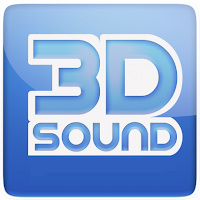 you’re not actually wearing headphones at all…and that’s really the point of this feature. I tried it out and found that overall, it had a natural effect and I believe most people will enjoy it. It actually did sound like I wasn’t wearing headphones…although I was:). This is fairly new technology in digital pianos and it’s a nice feature to have especially if you’ll be using headphones often. The 3D headphone sound effect only works when the ambiance button on the piano control panel is selected and it can be turned on or off or controlled in incremental levels. Also, it’s important to have/own good sounding stereo headphones for private playing because you want to capture all the nuances of the new enhanced Roland piano sound dynamics and tonal qualities and many low priced headphones don’t do that. You don’t need specific headphones to have that 3D effect but I can give you some good recommendations for quality stereo headphones if you don’t already have some.
you’re not actually wearing headphones at all…and that’s really the point of this feature. I tried it out and found that overall, it had a natural effect and I believe most people will enjoy it. It actually did sound like I wasn’t wearing headphones…although I was:). This is fairly new technology in digital pianos and it’s a nice feature to have especially if you’ll be using headphones often. The 3D headphone sound effect only works when the ambiance button on the piano control panel is selected and it can be turned on or off or controlled in incremental levels. Also, it’s important to have/own good sounding stereo headphones for private playing because you want to capture all the nuances of the new enhanced Roland piano sound dynamics and tonal qualities and many low priced headphones don’t do that. You don’t need specific headphones to have that 3D effect but I can give you some good recommendations for quality stereo headphones if you don’t already have some.
 The speaker/audio system in each model is very impressive because Roland is using newer audio technology not previously available on their pianos before. The best way for me to explain this is by referring to light bulbs. Most people know that saving electric energy and consuming less is the best way to go. The recent changes to light bulb technology now allows for a powerful bright light bulb which uses far less energy because of the new LED technology. So basically this means that instead of using 60 watts of power (per hour) to get 60 watts of light bulb brightness, the new LED bulbs use approx 14 watts of power to get 60 watts of brightness…and those new light bulbs last much longer because they are not using as much power as before. So when it comes to sound technology, it’s mostly all about wattage efficiency while offering good powerful volume (aka:decibel level) going through quality speakers and amplifiers that disperse the piano sound correctly and in a way that is most natural. Although having a lot of wattage power is not a bad thing in terms of achieving volume and sound fullness, that type of power method is using “old school” components at this point which are typically less efficient, more costly, and not as effective overall in some cases. It seems like many people want to go “green” these days so using less power and not having to replace components as often is a very good thing. The actual audio power of the DP603 is a total of 60 watts output in stereo, otherwise shown as 2 amplifiers at 30 watts each going into two 4.75″ speakers while only consuming 9 watts of power (per hour). 60 watts of total power is a lot of internal power in this price range, but I have heard this audio system before and it’s a bit weak in putting out a good bass response overall, but that’s true of other portable or compact pianos like this one. The Roland HP603 home cabinet model has the exact same audio and speaker specification as the DP603 so there is no difference in that way.
The speaker/audio system in each model is very impressive because Roland is using newer audio technology not previously available on their pianos before. The best way for me to explain this is by referring to light bulbs. Most people know that saving electric energy and consuming less is the best way to go. The recent changes to light bulb technology now allows for a powerful bright light bulb which uses far less energy because of the new LED technology. So basically this means that instead of using 60 watts of power (per hour) to get 60 watts of light bulb brightness, the new LED bulbs use approx 14 watts of power to get 60 watts of brightness…and those new light bulbs last much longer because they are not using as much power as before. So when it comes to sound technology, it’s mostly all about wattage efficiency while offering good powerful volume (aka:decibel level) going through quality speakers and amplifiers that disperse the piano sound correctly and in a way that is most natural. Although having a lot of wattage power is not a bad thing in terms of achieving volume and sound fullness, that type of power method is using “old school” components at this point which are typically less efficient, more costly, and not as effective overall in some cases. It seems like many people want to go “green” these days so using less power and not having to replace components as often is a very good thing. The actual audio power of the DP603 is a total of 60 watts output in stereo, otherwise shown as 2 amplifiers at 30 watts each going into two 4.75″ speakers while only consuming 9 watts of power (per hour). 60 watts of total power is a lot of internal power in this price range, but I have heard this audio system before and it’s a bit weak in putting out a good bass response overall, but that’s true of other portable or compact pianos like this one. The Roland HP603 home cabinet model has the exact same audio and speaker specification as the DP603 so there is no difference in that way.
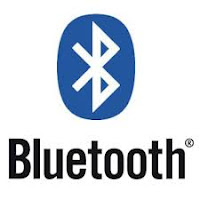

Another new technology now being put into these new Roland pianos is Bluetooth device connectivity. Bluetooth in digital pianos is relatively new and encompasses a number of separate features. So when you hear the word “Bluetooth” in digital pianos, it doesn’t mean they all do the same thing or can do everything associated with the Bluetooth technology. The Roland Bluetooth abilities include BT audio streaming so that you can hear the music from your Bluetooth capable external device (tablet, cell phone, computer, etc) such as iTunes come through the piano speaker system. Another Bluetooth feature is MIDI streaming connectivity so that you can interact with Bluetooth capable apps or programs such as Garage Band for iPad which is a great MIDI music and recording app. It is very popular for music education and lots of fun to use. So not only will the app respond to your Bluetooth input from the piano as you play the keys, but you can also hear the music audio coming from that app through the piano speakers. A third Bluetooth function is “pedal Air page tuning. This BT feature allows you to open up sheet music on your tablet with apps that have this “Air Page Turn feature so that you can download and read sheet music from your tablet and instantly turn the virtual pages by pressing a foot pedal on your piano exactly when you need to. One of those sheet music/page turning apps is called piaScore. With piaScore you can play thousands of songs from a free sheet music library through your tablet and turn the pages with Bluetooth page turner, and I previously mentioned. You can also import your own sheet music into the piaScore app so that you can have a custom library of songs that you can read directly from the app on your tablet device and be able to turn the sheet music pages with your Roland foot pedal page turner. So when it comes to Bluetooth and using that technology, there are still many apps that have not set up Bluetooth MIDI and/or Bluetooth audio or page turning yet. But as time moves along more and more of these app developers will do that to their music apps. In the meantime if you find some good iPad/Android music apps in the app store that respond to MIDI and audio but don’t have Bluetooth implementation yet, you can still connect the Roland piano to your tablet with the use of a USB connecting cable along with an audio cable which will do the same thing as Bluetooth audio and MIDI with the exception that it will not be wireless. But for many people that is just fine and the fact is you’ll still be properly connected with your Roland piano. Last but not least, Roland has developed a new Piano Partner 2 Bluetooth app that allows wireless BT connection so that you can access the sheet music to songs built into the DP603 as well as some educational note/sight reading digital flashcards in the app. Also, there are some interactive auto-accompaniment features generated by the app such as drum rhythm patterns and one-man band chord arrangement styles which you control by playing chords on the piano and hearing that accompaniment come through your piano as you play a melody and chords. It’s fun and engaging and can make you sound better than you are:).

Speaking of connectivity, the DP603 (just like the home cabinet models above it) have good connectivity to external devices with outputs and inputs including dual headphone jacks, stereo mini input audio jack to connect tablets, computers, iPod, etc to hear audio through the piano, two 1/4″ audio output jacks for stereo connectivity with external sound systems, USB flashdrive input, and USB output to device. This kind of connectivity is generally sufficient to meet most needs although all the jacks themselves are located under the left front of the pianos. This is fine for some connections but I would have much preferred to see the audio input and output jacks along with the USB output located on the back of the piano like most of the other brands do. It would be the more practical position for those connector jacks in my opinion, but perhaps Roland had a reason for locating all of them up front underneath the piano…maybe it was less money for them to do it that way…but I don’t like it near as much as on the back for those specific connectors. If you want to run an external device such as an iPad or computer to your piano then the audio cable needs to be routed to the front of the piano and same is true of a USB connected. Cables and connectors, especially audio output cables, should not be seen or get in the way of the player, but they do on the new Roland pianos and that would have been easy to do differently such as on past Roland models. It’s definitely not a “deal breaker” for me but it is an annoyance.
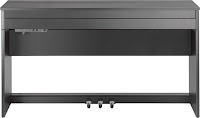
I do like the compact nature, size, and design of the DP603 and the cabinet color options are quite nice. But aside from the cabinet colors and finishes and the fact that the DP603 polished ebony or white comes with a nice full size matching bench, all DP603’s are the same otherwise. The dimensions of the DP603 are 55″x 15″x 39″ high (with the lid opened). With the lid closed flat the piano is only 31″ high. The weight of the DP603 is somewhere between 102 lbs and 106 lbs depending on the finish, so it’s fairly light but heavy enough that you would not want to move it too often. One important thing to know about the DP603 is that it is not considered a portable digital piano because the piano cannot be played without the furniture stand & pedals that come with it. So if you need something that you can take with you easily, the DP603 would not be a good choice in my opinion.
In the final analysis I believe Roland has finally hit the “sweet spot” in its quest for a compact digital piano in a good price range (depending on cabinet color & finish) by producing an instrument that focuses on recreating a more authentic piano playing experience along with incorporating this new technology in a smaller, nicely designed and well built cabinet at price a point that is affordable for many people, especially compared to some other digital piano brands and regular new acoustic pianos. Even though the DP603 has some very nice digital functions and lots of extra instrument sounds along with some fun
and educational features, this new model seems to mostly focus on the all important piano playing experience…and for me that’s what it’s all about, especially in this price range. The regular matte finish DP603 does not have any Roland bench with it. Be aware that this new Roland has no built-in drum patterns/beats, no auto-accompaniment interactive chords, no large color touch display screens, and no digital voice commands. But as I said, many of those “extras” are available on a tablet (iOS/Android) app if you want those things, when connected to the piano. This model is mainly for people wanting to play piano along with access to lots of non-piano sounds (some of which I like and some I don’t like so much), recording and other digital features The DP603 is an internet product in the US and can also be found at selected music & Roland piano stores. Based on the fact that the DP603 is a unique specialized model with regard to cabinet type and price point, I am guessing that you may have a difficult time finding one in person in your local area at this point. However since it is virtually the same piano as the current higher priced HP704, you may be able to find that model in Roland piano stores more easily which would then allow you to know exactly what the HP704 is like in terms of a piano playing experience. The DP603 has a 5yr parts and 2yrs labor warranty with in-home service, assuming you live close enough to a repair tech who can come to your home, which is not always the case…but this would be true for most name brands with factory warranties if a tech was not available to drive to your home.
If you want more info on new digital pianos and LOWER PRICES than internet discounts, please email me at tim@azpianowholesale.com or call direct at 602-571-1864.
